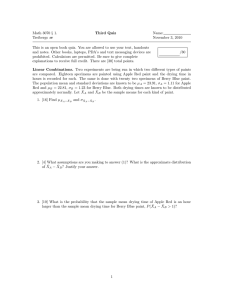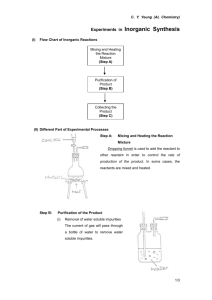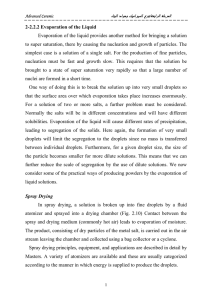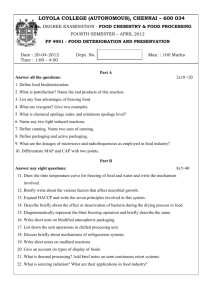Advance Journal of Food Science and Technology 6(4): 512-516, 2014
advertisement
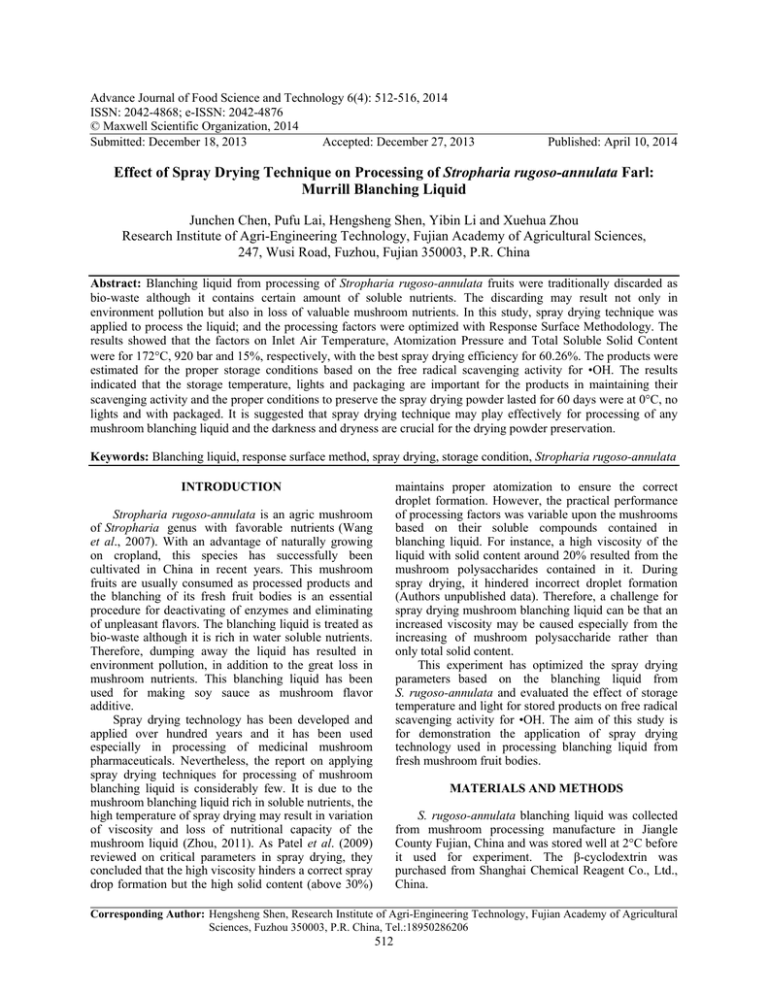
Advance Journal of Food Science and Technology 6(4): 512-516, 2014 ISSN: 2042-4868; e-ISSN: 2042-4876 © Maxwell Scientific Organization, 2014 Submitted: December 18, 2013 Accepted: December 27, 2013 Published: April 10, 2014 Effect of Spray Drying Technique on Processing of Stropharia rugoso-annulata Farl: Murrill Blanching Liquid Junchen Chen, Pufu Lai, Hengsheng Shen, Yibin Li and Xuehua Zhou Research Institute of Agri-Engineering Technology, Fujian Academy of Agricultural Sciences, 247, Wusi Road, Fuzhou, Fujian 350003, P.R. China Abstract: Blanching liquid from processing of Stropharia rugoso-annulata fruits were traditionally discarded as bio-waste although it contains certain amount of soluble nutrients. The discarding may result not only in environment pollution but also in loss of valuable mushroom nutrients. In this study, spray drying technique was applied to process the liquid; and the processing factors were optimized with Response Surface Methodology. The results showed that the factors on Inlet Air Temperature, Atomization Pressure and Total Soluble Solid Content were for 172C, 920 bar and 15%, respectively, with the best spray drying efficiency for 60.26%. The products were estimated for the proper storage conditions based on the free radical scavenging activity for •OH. The results indicated that the storage temperature, lights and packaging are important for the products in maintaining their scavenging activity and the proper conditions to preserve the spray drying powder lasted for 60 days were at 0C, no lights and with packaged. It is suggested that spray drying technique may play effectively for processing of any mushroom blanching liquid and the darkness and dryness are crucial for the drying powder preservation. Keywords: Blanching liquid, response surface method, spray drying, storage condition, Stropharia rugoso-annulata maintains proper atomization to ensure the correct droplet formation. However, the practical performance of processing factors was variable upon the mushrooms based on their soluble compounds contained in blanching liquid. For instance, a high viscosity of the liquid with solid content around 20% resulted from the mushroom polysaccharides contained in it. During spray drying, it hindered incorrect droplet formation (Authors unpublished data). Therefore, a challenge for spray drying mushroom blanching liquid can be that an increased viscosity may be caused especially from the increasing of mushroom polysaccharide rather than only total solid content. This experiment has optimized the spray drying parameters based on the blanching liquid from S. rugoso-annulata and evaluated the effect of storage temperature and light for stored products on free radical scavenging activity for •OH. The aim of this study is for demonstration the application of spray drying technology used in processing blanching liquid from fresh mushroom fruit bodies. INTRODUCTION Stropharia rugoso-annulata is an agric mushroom of Stropharia genus with favorable nutrients (Wang et al., 2007). With an advantage of naturally growing on cropland, this species has successfully been cultivated in China in recent years. This mushroom fruits are usually consumed as processed products and the blanching of its fresh fruit bodies is an essential procedure for deactivating of enzymes and eliminating of unpleasant flavors. The blanching liquid is treated as bio-waste although it is rich in water soluble nutrients. Therefore, dumping away the liquid has resulted in environment pollution, in addition to the great loss in mushroom nutrients. This blanching liquid has been used for making soy sauce as mushroom flavor additive. Spray drying technology has been developed and applied over hundred years and it has been used especially in processing of medicinal mushroom pharmaceuticals. Nevertheless, the report on applying spray drying techniques for processing of mushroom blanching liquid is considerably few. It is due to the mushroom blanching liquid rich in soluble nutrients, the high temperature of spray drying may result in variation of viscosity and loss of nutritional capacity of the mushroom liquid (Zhou, 2011). As Patel et al. (2009) reviewed on critical parameters in spray drying, they concluded that the high viscosity hinders a correct spray drop formation but the high solid content (above 30%) MATERIALS AND METHODS S. rugoso-annulata blanching liquid was collected from mushroom processing manufacture in Jiangle County Fujian, China and was stored well at 2°C before it used for experiment. The β-cyclodextrin was purchased from Shanghai Chemical Reagent Co., Ltd., China. Corresponding Author: Hengsheng Shen, Research Institute of Agri-Engineering Technology, Fujian Academy of Agricultural Sciences, Fuzhou 350003, P.R. China, Tel.:18950286206 512 Adv. J. Food Sci. Technol., 6(4): 512-516, 2014 Table 1: Parameters and estimated levels in Response Surface Method (RSM) Levels -------------------------------------------------Factors -1 0 1 160 170 180 IaT (x1) (°C) Ap (x2) (bar) 800 900 1000 TSC (x3) (%) 10 15 20 Methods: Slurry preparation: The blanching liquid was concentrated with rotary evaporator (SENCO-GG17, Shanghai Shenke Science and Technology Co., Ltd.) at 55°C with 0.098 MPa to obtain Total Solid Content (TSC) from original 3.2% up to requested. The βCyclodextrin (CD) was added into the slurry based on its TSC with ratio TSC: CD from 1:0.25 up to 1:1.5 with every 0.25 interval in CD portion. Spray drying of slurry: A SY6000 spray dryer (Shanghai Shiyuan Biotechnology Co., Ltd.) was used in this experiment. The feeding temperature was 70°C and the flow rate was 10 mL in per min. Variable parameters for optimization were Inlet air temperature (IaT, x1), Atomization pressure (Ap, x2) and Total Solid Content (TSC, x3) based on the evaluation of drying efficiency (y) for S. rugoso-annulata blanching liquid. The levels of variable parameters were described in Table 1 and optimized with Response Surface Method (RSM). DPS software (v6.55) applied for regression analysis and multinomial model fitting. Evaluations of spray drying: The drying efficiency and the persisted scavenging activity of the powder for free radical of •OH were determined. Based on the TSC in slurry (M0), the spray drying efficiency (Ye, %) was calculated by deducting moisture content (R) from the yield of spray drying powder (M) and formulated as: Ye (%) = M (1-R) /M0×100% The free radical scavenging activity for •OH was estimated with Fenton method and was estimated for liquid before drying (A1) and dissolved drying powder (A2) based on accordingly adjusting TSC of the solutions for both A1 and A2. Persisted Scavenging Activity of spray drying powder (PSA %) was determined to evaluate the effect of spray drying and storage conditions, described as: Fig. 1: Effect of β-cyclodextrin on drying efficiency and persisted antioxidant activity into each plastic bag and placed at 0 and 4°C for low storage temperature comparison, as well as placed at 20, 25, 30, 35 and 40°C, respectively, with or without light (kraft paper wrapped) to compare the interaction between storage temperature and light, 5 replicates for each group. Dissolving 0.5 g stored powder into distilled water and their free radical scavenging activity were compared with that of the powder before the storage time. Moisture absorption: The moisture absorption of drying powder was tested with gravimetric method. Weighing 1 g (±0.001 g) powder into an uncovered glass bottle and placed it in a desiccator together with a saturated solution to maintain a relative humidity in the desiccator, 5 replicates for each desiccator. Different saturated solution may result in relative humidity differently, such as saturated solutions of Lithium chloride for 11.28%, Magnesium chloride for 32.60%, Magnesium nitrate for 52.89%, Sodium chloride for 75.09% and Potassium nitrate for 92.31%. The desiccators with saturated solutions and samples were placed at 30°C and weighing each sample at every 2 h intervals. Moisture absorption of the powder (MA, %) was calculated by deducting previous weight (Wn-1) from current weight (Wn) then divided by weight at sampling time (W0), described as: MA (%) = (Wn - Wn-1) /W0×100% The moisture absorption rate was fitted for each relative humidity. RESULTS AND DISCUSSION PSA (%) = A2/A1×100% Preservation of drying powders: The effect of temperature with or without room lights on stored drying powder were evaluated by decreasing free radical scavenging activity for •OH. Five grams of drying powder were weighted accurately (±0.001 g) Effect of β-cyclodextrin on drying efficiency: The effect of β-Cyclodextrin (CD) on drying efficiency and persisted scavenging activity was showed in Fig. 1. The spray drying parameters were 170°C for IaT, 1000 bar for Ap, 15% for TSC of slurry and 70°C for Feeding Temperature (FT, °C). The addition of CD was from 513 Adv. J. Food Sci. Technol., 6(4): 512-516, 2014 Table 2: Drying efficiency obtained with response surface analysis x2 x3 Ye (%) Code x1 1 1 1 0 55.21 2 0 0 0 63.44 3 -1 0 -1 48.14 4 0 0 0 61.58 5 0 -1 1 48.23 6 0 1 1 50.11 7 -1 -1 0 44.26 8 1 -1 0 42.12 9 0 -1 -1 46.44 10 0 0 0 59.45 11 1 0 -1 52.10 12 0 0 0 60.08 13 -1 0 1 48.14 14 0 0 0 59.12 15 -1 1 0 45.11 16 0 1 -1 54.11 17 1 0 1 53.11 Table 3: Analyses of variance with regression model S.S. Def M.S. F Xi x1 35.66 1 35.66 15.090 x2 68.97 1 68.97 29.190 x3 0.18 1 0.18 0.076 x1x2 37.45 1 37.45 15.580 x1x3 0.26 1 0.26 0.110 x2x3 8.38 1 8.38 3.550 x21 189.26 1 189.29 80.090 x22 227.24 1 227.24 96.370 x23 56.31 1 56.31 23.830 Model 674.40 9 74.93 31.710 Residual 16.54 7 2.36 Lack of fit 3.82 3 1.27 0.400 Pure error 12.72 4 3.18 Total coeff. 690.94 16 R2Adj = 0.9453 R2Reg = 0.9761 S.S.: Sum of square; M.S.: Mean square p 0.0060 0.0001 0.7905 0.0053 0.7521 0.1017 <0.0001 0.0001 0.0018 <0.0001 0.7608 3.75, 7.50, 11.25, 15.00, 18.75 and 22.50% based on the ratio of TSC: CD as 1:0.25, 1:0.50, 1:0.75, 1:1.00, 1:1.25 and 1:1.50, respectively. The drying efficiency (Ye, %) and antioxidant retention rate (PSA) were increased dramatically while CD portion increased from 1:0.25 to 1:1, then both were maintained although the ratio of CD was consistent up to 1:1.50. As reviewed by Patel et al. (2009), although the addition of CD to blanching liquid increased TSC of the liquid in dissolved phase and maintained the actives of blanching liquid in certain extent, the more energy was also requested for drying such high density slurry with increased TSC and a glass transition temperature for CD (at 173°C) might affect its molecular linkage and formation of droplets (Cui et al., 2006; Huang et al., 2007). Optimization of drying factors with RSM: The drying efficiency (Ye) of the liquid was listed in Table 2 by variable factors and their variation levels. The variation analyses of 3 factors were listed in Table 3. The quadratic regression analysis gave the regression equation of response surface with independent variable factors, including IaT (x1), Ap (x2) and TSC (x3). The regression model for predicting of drying efficiency (Ype, %) was described as followed: Ype (%) = 60.73 + 2.11x1 + 2.49x2 - 0.15x3 + 3.0 6.42 x1x2 + 0.25 x1x3 + 1.45 x2x3 6.70x 12 - 7.35x22 - 3.66x23 Data in Table 3 indicated that the predicted yield (Ype, %) from regression model (R2Reg = 0.9761) could be significantly matched to it practically obtained from (Pmod<0.0001). The impact order of three factors was followed as: Ap x2>IaT x1>TSCx3 and the effect of x3, x1x3 and x2x3 was not significant on prediction for drying efficiency Ype (%) with the regression equation. The interaction between IaT and Ap (x1x2) significantly affected the prediction of drying efficiency (Ype%, p<0.01) as revealed in Fig. 2. Between 160-180°C, the drying efficiency (Ype,%) was increased while increasing inlet air temperature but it was tended in reducing while as the atomization pressure going up under the Inlet air temperature in certain. 514 Adv. J. Food Sci. Technol., 6(4): 512-516, 2014 Fig. 2: Response surface and contour plots of Ype (%) versus inlet air temperature and atomization pressure A: Inlet air temperature; B: Atomization pressure Fig. 3: Effects of storage temperature, lights and moisture absorption on maintaining the scavenging activity for •OH free radical of stored drying powder, (a) low temperature storage, (b) room temperature, (c) lights, (d) moisture absorption under different relative humidity Effect of storage temperature and lights: After 7 weeks storage period, the scavenging activity of stored powder for free radical of •OH was decreased from 75 to 65 and 58% for the powder stored at 0 and 4C, respectively, as indicated in Fig. 3a by dashed lines. Same decreasing trends on free radical scavenging activity of drying powder were revealed in Fig. 3b and showed differences resulting in room temperature storage conditions. Moreover, the enhancing in impacts of temperature on the decrease of free radical scavenging activity of the stored powder may result from illumination as showed in Fig. 3c. The relative 515 Adv. J. Food Sci. Technol., 6(4): 512-516, 2014 humidity of storage place was also critical for maintaining the free radical scavenging activity, especially in relative humidity higher than 30% (Fig. 3d). CONCLUSION Spray drying technology can be used in processing of mushrooms blanching liquid. With optimized spray drying factors, the addition of β-cyclodextrin has indicated its effect on improving spray drying efficiency and maintaining free radical scavenging activity of the drying products. The proper ratio of Total Solid Content: β-cyclodextrin is suggested as 1:1 when total solid content of mushroom liquid between 15-20% although it can be varied upon mushroom species. Inlet air temperature, Atomization pressure and Total soluble solid content are important factors which should be accordantly adjusted by the major compounds in liquids for spray drying. In addition, low temperature, no light and packages are crucial to maintain drying powder. REFERENCES Cui, B., Z. Jin, W. Zhou, C. Bi and X. Cao, 2006. Study on thermal decomposition kinetic parameters of glucosyl (α-1→6-β-cyclodextrin). Sci. Technol. Food Ind., 27: 55-57. (In Chinese) Huang, L., R. Zhou and S.A. Mujurndar, 2007. Variation of glass transition temperature and control of product quality during pray drying. Chem. Ind. Forest Prod., 27: 43-46. (In Chinese) Patel, R.P., M.P. Patel and A.M. Suthar, 2009. Spray drying technology: An overview. Indian J. Sci. Technol., 2: 44-47. Wang, X., W. Zhan, M. Tao, Z. Ji, Y. Liu, F. Wang and G. Cheng, 2007 Analysis on nutrient components and antioxidant components of Stropharia rugosoannulata. Edible Fungi, 29: 62-63. (In Chinese) Zhou, X., 2011. The spray drying technique research in stropharia blanching water. M.S. Thesis, Fujian Agriculture and Forest University, Fuzhou, China. (In Chinese) ACKNOWLEDGMENT The authors thank the National Ministry of Agriculture, China for Special Fund for Agro-scientific Research in the Public Interest (No. 201303080). 516

